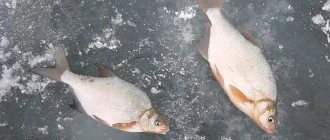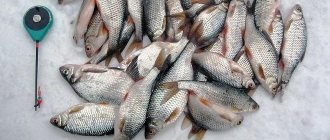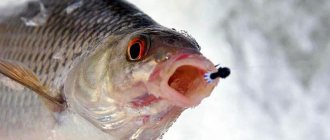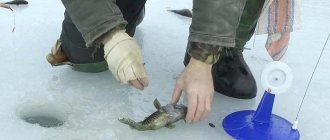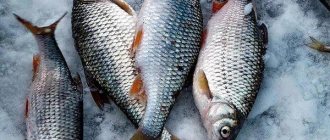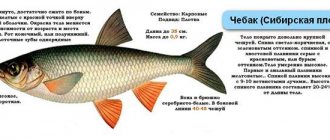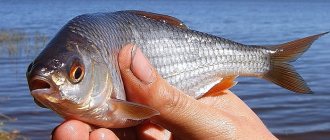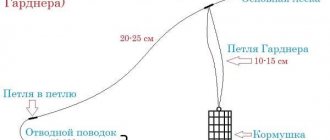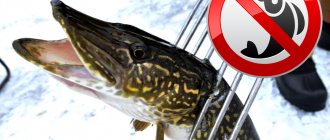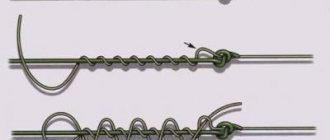You can catch large roaches only in those reservoirs where they are not very numerous in number and there is enough food. More often these will be bodies of standing water or reservoirs. In winter, roach should be looked for in the middle layers of water (2-3 m); in the dark period it goes even deeper. Large individuals prefer deep water and places near snags and flooded bushes. The fishing location is chosen based on the coastal edge: where streams flow into the reservoir and grass grows in summer, there is no fast current. Throughout the winter period, as experienced fishermen have repeatedly seen, roach can only be found in reservoirs with underwater springs and at the mouths of small rivers. Read how to catch it on 34fish.ru.
Briefly about fish: Features and types of roach
Scientists classify all varieties of roach (Latin name Rutilus rutilus) as members of the carp family. In Russia, this species is dispersed quite widely, starting from the westernmost regions - the Kaliningrad region, in the south - on the Don and Volga, to the rivers located in the North of the Urals.
This fish has not spread its habitat only in the east - the rivers of the Amur basin and others flowing into the Pacific Ocean. Many scientists are still studying why, because the roach is quite unpretentious to its habitat and food supply.
Scientists distinguish several subspecies of roach:
- Residential; - Passage.
Residential, characterized by rather slow growth. The anadromous form grows faster, usually gaining a maximum length of 12-19 centimeters by 3-4 years. There are examples when caught individuals reached a length of 20-25 centimeters, although these cases are quite rare.
How to Catch Roach in Summer?
In summer, it is necessary to take into account the factor of the spring spawning period, after which it actively feeds. Large specimens of fish of this species usually gather in small schools, and biting activity begins at dawn with very careful bites.
Most often, the roach takes 10-15 cm (sometimes up to half a meter) from the bottom, since it feeds at this depth. When fishing from the shore, it is better to use a light rod, 4 to 6 meters long.
The fishing line is selected with a diameter of 0.10 to 0.15 mm, with a thin leash. The optimal hook sizes are No. 13 (hereinafter according to the international classification) for worms and No. 17 for bloodworms.
The most effective way to catch roach on lakes at this time is to fish with a float rod.
Fishing with a jig with a side nod has also proven successful. Thanks to the conical shape of the nod, we have the opportunity to select jigs of different weights, which has a beneficial effect on its smooth, even play. At the same time, by changing the length of the nod, we change the quality of the bait's performance.
We will give preference to bloodworms as bait (the more active the bite, the greater the amount of bait should be).
The so-called “sandwich” consisting of bloodworms and maggots has proven itself well as a bait.
Maggot can also be used separately. Goose or cuttlefish can be used as bait in summer. After heavy rains, the roach actively takes on an ordinary dung worm or a piece of earthworm.
When using bait, it should be taken into account that roaches are more active in the bait, the basis of which consists of live bait.
Catching Roach in Summer with Oleg Kvitsinia (Video)
What does a roach like and eat?
The main food source for roaches is various algae, insect larvae, and grass. In the event of a shortage of food, which constitutes its main food, the roach can switch to feeding on the eggs of other fish.
There are examples when it feeds on 2-valves mollusks, which in turn gives a significant increase in the body weight of the fish in a short time, due to the rich protein content in the body of the mollusk. And this leads to the similarity in appearance of roach to roach.
In our central zone, the most numerous species of fish is roach, which is why its fishing is so popular.
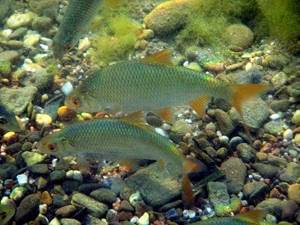
Of course, crucian carp can be called a food competitor of this fish, but with several reservations:
— He is active only in the summer. As a rule, its habitat is small bodies of water - small rivers, lakes. In the winter season, roach predominates in the catches of fishermen, since it is active at any time of the year.
In this regard, most fishermen pay close attention to roach fishing.
The influence of weather on the bite
Roaches bite unstably in winter. And the reason for this is the weather and water conditions. Underwater currents, water temperature, movement of zooplankton masses, dissolved oxygen levels - everything affects the bite. It has been noticed that any fish bites better in constant weather, without sudden jumps and changes. It should be taken into account that in cold water fish do not need a lot of food, since calorie consumption with a slowed metabolism is small. At what pressure does a roach bite better in winter?
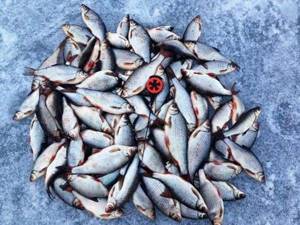
Influence of atmospheric pressure
The fish feels great at both high and low atmospheric pressure. The pressure itself does not directly affect her condition - this is a myth. Pressure is simply a measure of atmospheric changes. As the weather changes, the situation in the reservoir also changes, and feeding cycles shift. When the bite is bad, you should complain not about the weather, but about the wrong fishing tactics. With sudden changes, the fish simply do not have time to adapt to the new conditions. The biting at this time can either stop or resume with renewed vigor. The fish may not bite even in seemingly fine weather - simply because it has already eaten enough the day before.
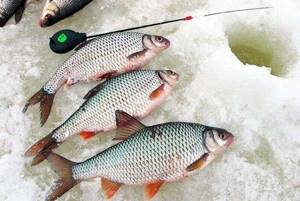
So in what winter weather does roach bite best?
The best atmospheric pressure for catching roach is constantly high, average or slightly below normal. The main thing is that there are no sudden jumps. Uniform, gradual changes are acceptable. The soroga is active all winter. Therefore, in January and February, when other fish are not particularly active, fishing can be very successful, as long as weather conditions permit.
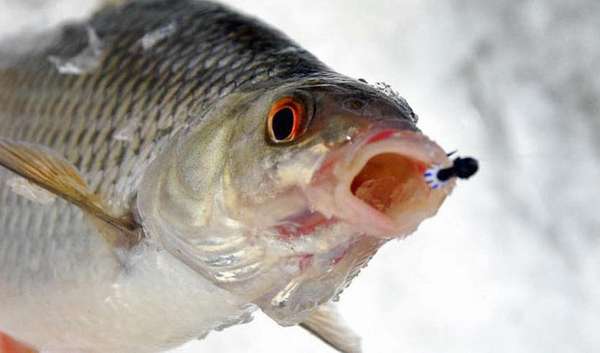
Wind influence
The wind also affects the bite. In strong and gusty winds, fish are often not caught. This is more relevant for large bodies of water. Even thick ice in strong winds on reservoir areas moves in waves, which are noticeable only by fluctuations in the water level in the hole. At such moments the bite is poor or non-existent.
For biting, you need quiet, stable weather, without surges in atmospheric pressure, sudden increases and decreases, and without strong gusty winds. Other weather factors are not so important - fish are caught both in the thaw and in twenty-degree frost, day and night.
Where to look for roach? Its habitats
Usually, in winter, fishermen go for roach as soon as the ice on the reservoirs becomes more or less strong. The roach is medium to large in size and lives in shallow areas up to 1.5-2 meters, mainly near dumps or various edges, as well as other uneven areas of the bottom.
You can successfully catch roach near the mouths of streams or small rivers, near thickets of bushes, snags and other places that can serve as shelter for fish. Collection areas for dry or aquatic vegetation may be quite promising places.

As a rule, roaches do not change their stopping places, and knowing with great confidence the places where the fish were last year, you can catch them this year with the same success.
Of course, except for cases when the water flow regime and hydrological situation could change - for example, if bank protection work was carried out or the river bed was cleaned. At the beginning of winter, during the period of first ice, roach can be caught in fairly large quantities. True, this lasts no more than two weeks.
This is due to the fact that there is still a fairly high level of oxygen in the water, and roach, like any other fish, is as active as possible. After two or three weeks, the activity of the roach will begin to decline and will resume only in the spring.
Playing technique
Examples of bait games:
- Smoothly, without jerking, we lower the jig to the very bottom. Then, we also slowly raise it to a height of 5 cm and hold it for a few seconds. Then we lower and raise again - we get a swaying nod.
- We lower the jig to the bottom and lightly lift it up 20-30 cm with frequent vibrations.
- Slowly lower it to the bottom and hold it without moving.
- After active techniques, we stop the jig, almost touching the ground, and slowly stir it.
- Raising the jig up, we make slight jerks and swing the fishing rod in different directions.
- With small twitches, we move the jig at the desired depth, and thereby lift it up.
- We quickly lower it and knock it on the bottom two or three times to raise the turbidity and attract fish.
We lift the jig slowly, then faster, then even faster. Hold for 2 seconds when changing tempo.
A comprehensive video on how to catch roach in winter: . Very indicative and well reflecting all the features of ice fishing.
When playing with bait, the most important thing is to set the pace and remember to pause for a second . Try to fish not only in the bottom layers, but also two to three meters higher. The fish perceive the jig as some kind of living organism that they feed on in this body of water.
At the beginning of winter, the fish are active and the amplitude of oscillations will need to be fast. In the middle of winter, the fish behaves inactively, which changes the amplitude of oscillations to decrease and the number to increase. The number of vibrations per minute in winter is slightly reduced to 200-300 beats than in summer.
The bait game has many variations, it is the angler's creativity. All of the above can be taken as basics, and you can use only your imagination.
Catching roach in winter with a float rod
You can catch roach in winter, as well as bream, using a winter float rig; this is exactly the type of fishing that attracts anglers.
For winter fishing with a float rod, you can use any fishing rod, since the float, and not the nod, serves as a bite alarm.
3 ways to improve your fish bite!
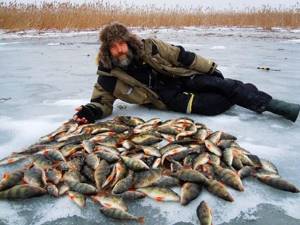
Over 15 years of active fishing, I have found many ways to improve the bite, and here are the most effective:
1. Bite activator . This pheromone additive attracts fish most strongly in cold and warm water. The Fish Hungry bite activator has proven itself to be excellent - Read more…
2. Tackle with increased sensitivity . You should first familiarize yourself with the features of using a particular type.
3. Pheromone baits . They attract the attention of fish, stimulate hunger and cause a schooling reflex, which allows you to collect a lot of fish in one place.
You can get the rest of the secrets of successful fishing for free by reading my other materials on the site.
3 ways to improve your fish bite!
Over 15 years of active fishing, I have found many ways to improve the bite, and here are the most effective:
1. Bite activator . This pheromone additive attracts fish most strongly in cold and warm water. The Fish Hungry bite activator has proven itself to be excellent - Read more…
2. Tackle with increased sensitivity . You should first familiarize yourself with the features of using a particular type.
3. Pheromone baits . They attract the attention of fish, stimulate hunger and cause a schooling reflex, which allows you to collect a lot of fish in one place.
You can get the rest of the secrets of successful fishing for free by reading my other materials on the site.
You don't want to use rods that are too long, but rods that are too short will also be uncomfortable. The best is up to 30 cm, there is no need for anything longer. It is also worth paying attention to the weight of the rod, since if there is a strong side wind, and this can happen quite often, the rod will be blown away.
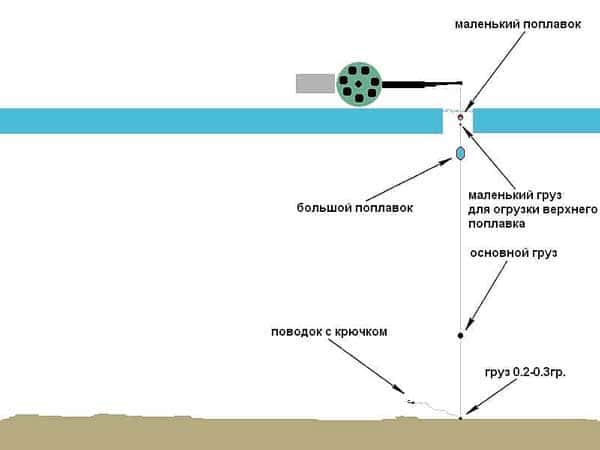
Winter float equipment for roach has the following components:
- A small float , shaped like a cone - 3 - 5 cm; — Sinker in the form of a pellet. This is the case if a hook is used. If you use a jig instead of a hook, then when setting up the equipment, the weight of the jig also needs to be taken into account; - Leash , 10-15 cm long. The line for the leash is selected according to the weight of the fish being caught - 0.10-0.12 mm; — The fishing line should be 0.14-0.18 mm. Although it is now possible to use thinner lines, fortunately they are of better quality, thinner and stronger every year.

With various changes in weather or atmospheric pressure, the roach behaves more carefully and it is necessary to use more finely tuned gear:
— The hook is smaller than usual; —Leash of smaller diameter; — Small and light float . This is provided that there is no strong current and the depth is fairly shallow, otherwise the tackle will simply be carried away.
In the dead of winter, when the roach is inactive, its bites will be barely noticeable, but it is still possible to see them. And being attentive and focusing your gaze on the float will help you with this.
Floats for winter fishing are sold at any fishing store, or you can make them yourself from polystyrene foam. The main thing is that it has sufficient carrying capacity and is small in size.
Winter fishing for roach with a float. Labor fishing. Video
What time of day is the bite best?
Fishing is successful throughout the whole day, but is more active in the morning before lunch and in the evening, two hours before dusk. In a well-fed hole, fishing can last until night. So even in a snowy winter, although it is not easy, it is possible to reel in a decent catch.
Twilight over the ice hole is a necessary condition for winter fishing. To create shade, tents or huts are erected. The bite in winter is stable. Only during severe frosts and piercing winds does the fish not give in. The hole can also be covered with a piece of plywood to protect it from light that frightens the fish.
Roach is very sensitive to weather changes . On sunny days, it migrates into the pond in large flocks, but already in mid-December to early February it becomes sluggish, almost motionless, and all the proposed bait does not impress it. You need to try to throw the bait right under her nose or “seduce” her by playing with the bait.
Catching roach with a jig
Also in winter, roaches are also caught using a jig, an important factor of which is the choice of the optimal diameter of the fishing line and the type of jig.
We know that the worse the fish bite, the smaller the diameter of the fishing line should be. But, if you plan to catch roaches larger than average, then you need to select the appropriate equipment for this. To do this, naturally, you need to increase the diameter of the fishing line to 0.15-0.18 millimeters.
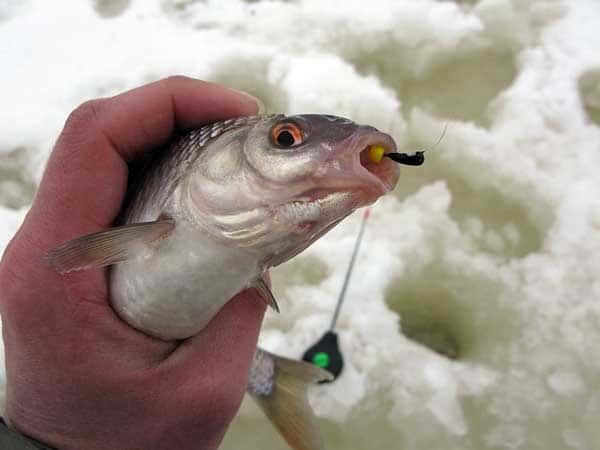
Sometimes, in rare cases, the angler must take into account such a factor as the transparency of the water in the reservoir. Thus, excessively clear water can scare fish away from the fishing spot. But this is most likely suitable for first ice, when there is no snow on the ice and the ice is transparent and smooth.
When fishing with a jig, it is better to use the softest fishing lines. Since playing a jig with a soft fishing line is much more effective than with a hard one.
Although, if it is windy outside, then a soft fishing line will not be entirely convenient, since it will get tangled on ice 2 times more often than a hard one. Also, when fishing for roach, it is not necessary to make too sharp hooks when biting, this can lead to large fish leaving when landing.
The most popular jigs for roach
I would like to give you one more piece of advice on catching roach in winter. If the roach's bite suddenly weakens, it is necessary to carry out additional feeding of the hole.
The main thing is not to bring the feeder to the bottom, but to dump the bait at a distance of 20-40 cm above the bottom. This is necessary so that the food is evenly distributed on the bottom in the fishing area and attracts fish.
And if she approaches, the bait should keep her in this place for a long time, this is the whole essence of the bait.

Bait for roach
You should start fishing by preparing and feeding several holes located 10 meters from each other. It’s not difficult to buy bait in the store, but trying it out will take a lot of time. You can cook it at home no worse, even better, than store-bought.
Store-bought bait for roach:
- Flagman PROFESSIONAL;
- Fish Dream;
- Megamix Black roach;
- Bomb Roach Gold series.
In winter, the water is cold and the presence of a dusty cloud from the food is important when preparing bait.
DIY bait recipe:
- corn – 250 g;
- buckwheat – 150 g;
- pearl barley – 100 g;
- breadcrumbs – 300 g;
- peas – 100 g;
- orange zest – 30 g;
- basil – 30 g;
- hemp grains -50 g;
- coriander – 30 g;
- salt – 10g.
Fry all ingredients in a frying pan until golden brown. Transfer to a bowl and blend with a blender. The base is ready. Before use, dilute a little with water from the reservoir where you will be fishing. The consistency should be viscous. Try to make the bait dark; roaches don’t really like light spots in winter. Roach like natural bait. The jig is the most catchy, and the dung worm is sometimes better than the bloodworm. It is specially grown in cellars for winter fishing.
There are nozzles:
- vegetable (used in stagnant water) - bread, steamed grains, pearl barley, egg.
- of animal origin (in running water) - bloodworms, maggots, caddis flies.
It is necessary to maintain the freshness of the nozzle. A beautiful, and most importantly, living worm will be able to attract the attention of a worthy roach. To catch large fish, a jig is required. The selection of color depends on the fishing conditions: depth, light (varies due to the thickness of the ice) and bait. Large and medium-sized fish are concentrated on edges two meters deep or uneven areas of the bottom.
Using two fishing rods at the same time will help you have a better chance of a good catch. Drill two holes at a distance of half a meter from each other so that you can catch with both hands at once. By raising the left fishing rod, the right one is lowered, thereby creating turbidity at the bottom. Don't forget to pause periodically.
